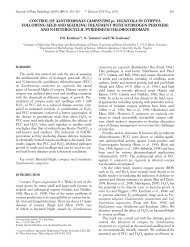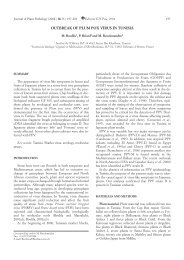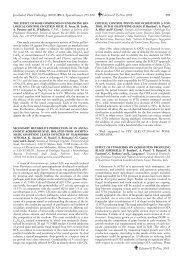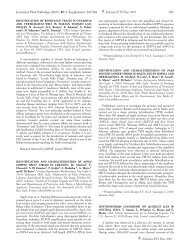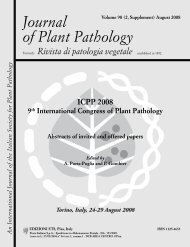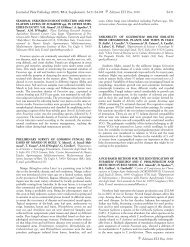Journal of Plant Pathology - Sipav.org
Journal of Plant Pathology - Sipav.org
Journal of Plant Pathology - Sipav.org
You also want an ePaper? Increase the reach of your titles
YUMPU automatically turns print PDFs into web optimized ePapers that Google loves.
<strong>Journal</strong> <strong>of</strong> <strong>Plant</strong> <strong>Pathology</strong> (2011), 93 (1, Supplement), S1.43-S1.51 S1.51<br />
were tested in the years 2007 to 2009 in commercial vineyards<br />
along the Luxembourgian part <strong>of</strong> Moselle. The trials were conducted<br />
in cvs Pinot blanc and Pinot gris, which are typically<br />
grown in Luxembourg and are highly susceptible to grey mould<br />
due to their compact cluster structure. The aim <strong>of</strong> the studies was<br />
the development <strong>of</strong> sustainable management practices for efficient<br />
bunch rot control strategies. The investigated management<br />
practices consisted <strong>of</strong>: (i) leaf removal in the cluster zone directly<br />
after flowering (BBCH 71) on the north or east sides <strong>of</strong> the rows;<br />
(ii) application <strong>of</strong> the plant growth regulator Regalis (a.i. prohexadione-Ca)<br />
at full blooming (BBCH 65); (iii) application <strong>of</strong><br />
the botryticide Teldor (fenhexamid) at cluster closure (BBCH<br />
77), singly or as several combinations <strong>of</strong> them. The impact <strong>of</strong><br />
these different strategies on cluster morphology, harvest parameters,<br />
such as yield, sugar level and total acidity, grape health status<br />
and possibility to prolong the ripening period were investigated.<br />
The use <strong>of</strong> Regalis led to a considerably more flexible cluster<br />
structure and to a slight decrease <strong>of</strong> grey mould severity. The reduction<br />
<strong>of</strong> the bunch rot infestation level was similar to that obtained<br />
by a single application <strong>of</strong> the botryticide Teldor at BBCH<br />
77. Leaf removal also reduced cluster density and was more efficient<br />
against B. cinerea than the chemical treatments (reduction<br />
<strong>of</strong> grey mould disease severity <strong>of</strong> more than 50% in average).<br />
Presumably, the reduction <strong>of</strong> assimilation leaf area led to a disaggregation<br />
<strong>of</strong> cluster structure. Furthermore, the better sun and<br />
wind exposure allowed for a faster drying process. Thus, leaf removal<br />
in the cluster zone shortly after bloom can be recommended<br />
as a standard measure in integrated as well as in <strong>org</strong>anic<br />
bunch rot protection strategies. The best loosening effect on the<br />
cluster structure as well as the best B. cinerea reduction efficiency<br />
were achieved when leaf removal and a Regalis application were<br />
combined. However, this combination reduced the yield, depending<br />
on the variety, the year and the location <strong>of</strong> the vineyard,<br />
by about 20% in average. The combination <strong>of</strong> leaf removal and<br />
botryticide application showed comparable efficiencies, though<br />
the yield reductions were lower. Simulations <strong>of</strong> B. cinerea epidemic<br />
indicated that all treatments tested might enable a longer<br />
persistence <strong>of</strong> the bunches on the vines due to lower infection.<br />
Thus, the presented strategies can be recommended to maximize<br />
wine quality in two ways, i.e. reduction <strong>of</strong> fungal contamination<br />
and/or improvement <strong>of</strong> grape maturity. The longest potential harvest<br />
delay (around 10 days in average) until reaching an assumed<br />
threshold <strong>of</strong> 5% disease severity was achieved by combining leaf<br />
removal and the application <strong>of</strong> Regalis or a botryticide.<br />
LENGTH OF THE INCUBATION PERIOD OF GUIGNAR-<br />
DIA BIDWELLII. D. Molitor 1,2 , C. Fruehauf 3 , O. Baus 1 and B.<br />
Berkelmann-Loehnertz 1 . 1 Geisenheim Research Center, Section <strong>of</strong><br />
Phytomedicine, Von-Lade-Strasse 1, 65366 Geisenheim, Germany.<br />
2 Centre de Recherche Public-Gabriel Lippmann, Department Environment<br />
and Agro-Biotechnologies, 41 Rue du Brill, 4422 Belvaux,<br />
Luxembourg. 3 Deutscher Wetterdienst (German Meteorological<br />
Service), Centre <strong>of</strong> Agrometeorological Research, Bundesallee 50,<br />
38116 Braunschweig, Germany. E-mail: dmolitor@lippmann.lu<br />
Black rot, caused by Guignardia bidwellii, is a grape disease <strong>of</strong><br />
North American origin first recorded in Europe at the end <strong>of</strong> the<br />
19th century. Since 2002, black rot became established in the<br />
northern grape-growing areas <strong>of</strong> Germany and currently represents<br />
regionally one <strong>of</strong> the major fungal grape diseases. The<br />
length <strong>of</strong> the incubation period is <strong>of</strong> special interest for scheduling<br />
curative as well as protective control measures. To determine<br />
the impact <strong>of</strong> temperature conditions and <strong>of</strong> the developmental<br />
stage on the length <strong>of</strong> G. bidwellii incubation period, studies<br />
were conducted at the Geisenheim Research Center in 2006 to<br />
2008. The aim was to develop algorithms to determine the length<br />
<strong>of</strong> the incubation period based on cumulative degree-days after<br />
infection. Current knowledge tells that the incubation period <strong>of</strong><br />
G. bidwellii on both leaves and clusters <strong>of</strong> cvs Riesling, Mueller-<br />
Thurgau is strongly correlated with temperature conditions. For<br />
the mathematical description <strong>of</strong> this correlation, a new temperature-based<br />
model to calculate the incubation period length was<br />
developed. The following criteria have to be taken into consideration<br />
when calculating the temperature sums: (i) mean daily temperatures<br />
(t av<br />
) below 6°C are included in the average sum calculation<br />
with an assigned value <strong>of</strong> 0°C; (ii) when the mean daily temperature<br />
is above 6°C, (t av<br />
-6)°C is included in the calculation; (iii)<br />
when mean daily temperatures rise above 24°C, 18°C (i.e. 24 minus<br />
6°C) will be considered in the average sum calculation. First<br />
disease symptoms appear on the leaves after reaching a threshold<br />
temperature sum <strong>of</strong> 175 cumulative degree-days. The length <strong>of</strong><br />
the incubation period on clusters is additionally affected by the<br />
developmental stage. Until reaching the phenological stage<br />
“berries begin to touch“ (BBCH 77), the length <strong>of</strong> the incubation<br />
period on cv. Riesling clusters is as long as on leaves. With ongoing<br />
development, the length <strong>of</strong> the incubation period increased<br />
continuously. Due to this, after reaching the stage “majority <strong>of</strong><br />
berries touching” (BBCH 79), a correction factor for cluster phenology<br />
has to be taken into account to calculate the temperature<br />
sum thresholds for the occurrence <strong>of</strong> first symptoms. This specific<br />
information on the current state <strong>of</strong> fungal development in the<br />
host-plant and the expected date <strong>of</strong> the occurrence <strong>of</strong> new symptoms<br />
opens up innovative options for a more precise scheduling<br />
<strong>of</strong> fungicide based strategies to control grape black rot.<br />
INNOVATION TO CONTROL DOWNY MILDEW ON<br />
GRAPES. L. Triebus. Bayer CropScience, Alfred Nobel Strasse 50,<br />
Building 6100, 40789 Monheim, Germany. E-mail: ludger.triebus<br />
@bayercropscience.com<br />
Downy mildew, caused by Plasmopara viticola, is one <strong>of</strong> the<br />
most important and damaging diseases on grapes that has considerable<br />
negative economic impact worldwide. Bayer has invested<br />
significant resources over the last few years to develop a new alternative<br />
fungicide that meets all the needs <strong>of</strong> modern agriculture<br />
in providing improved disease control. PROFILER is the new, innovative<br />
technology developed by Bayer CropScience, that combines<br />
the properties <strong>of</strong> two active ingredients with different<br />
modes <strong>of</strong> action to give outstanding efficacy against downy<br />
mildew. Firstly, fluopicolide a new active ingredient provides<br />
both curative and anti-sporulant activity to control the disease at<br />
several points in the P. viticola life cycle. Fosetyl-Al, the active ingredient<br />
in the well established product Aliette, has complete systemic<br />
properties moving in both xylem and phloem as well as<br />
providing strong indirect stimulation <strong>of</strong> the plant’s natural defense<br />
system. Fluopicolide is active at low dose rates against all<br />
oomycete-induced diseases and has been shown not to be crossresistant<br />
to any other commercial fungicide used in grapes. From<br />
the trial results obtained during five years <strong>of</strong> intensive testing in<br />
vineyards <strong>of</strong> France, Italy, Germany, Spain and Portugal, PRO-<br />
FILER applied at 2.25 to 3.0 kg/ha, throughout the season or<br />
three times around the blooming period, showed its excellent efficacy,<br />
superior to commercial standards, to protect leaves and<br />
bunches against downy mildew, even when applied at 14 day<br />
spray intervals. As part <strong>of</strong> our anti-resistance management strategy,<br />
a maximum <strong>of</strong> three applications <strong>of</strong> PROFILER are recommended<br />
per crop per season in grapes from blooming up to<br />
bunch closure, with a spray interval <strong>of</strong> 12 to 14 days.



